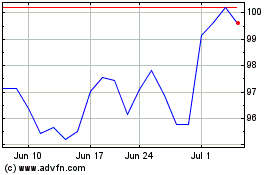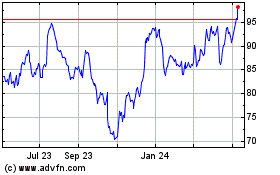By Telis Demos
Will machines take over the bond market too?
Banks including Credit Suisse Group AG, Goldman Sachs Group
Inc., and Morgan Stanley are all making bets in that direction,
unleashing new trading software systems in recent months to pick up
share in the $6 trillion market for investment-grade corporate
debt.
In part because of its complexity and relatively low liquidity,
that corner of Wall Street has been one of the more resistant to
technological changes sweeping trading, lending and just about
everything else in banking. A recent study by the Bank for
International Settlements estimated that only 40% of
investment-grade corporate bond trading was executed through
computers rather than over the phone, compared with 75% in
Treasury-debt trading, 80% in stocks and 90% in a broad array of
futures contracts.
Now, investment banks are pushing to stoke more electronic
trading in the market, especially with small trades that otherwise
might fall through the cracks. It is yet another example of banks
turning to technology to try to generate revenue growth at
relatively low cost.
Starting with smaller trades, those under $1 million, is a safer
route for the banks because it doesn't threaten the profit margins
on the big trades they do with institutions.
While the banks are taking it slow, the smaller trades
eventually may be a precursor to fully automating some bigger
trades, which are often trickier to execute and require more human
hand holding.
"Banks see an opportunity to take advantage of trading
opportunities they were missing in the past," said Richard
Schiffman, head of open trading at MarketAxess Holdings Inc.,
operator of an electronic bond-trading network.
Some past efforts to change the patterns of bond trading have
met resistance or petered out. Platforms offered several years ago
by Wall Street players including Goldman and money manager
BlackRock Inc. were shelved or integrated into other efforts.
But more recent initiatives, such as networks connecting bond
investors to trade with each other, have started to show
traction.
Credit Suisse launched its system, called CSLiveEx, earlier this
year, making the decision to fully automate the smallest trades in
the U.S. market for bonds of corporations with top credit. That
means the trades have no direct human involvement.
In corporate bonds, traders working the phone still dominate the
market, in part because there are so many various bonds to follow,
all with different permutations such as maturity and yield. Some
corporate bonds also don't trade that often after their initial
sale, even for major companies like Apple Inc. In that type of
market, human salespeople who can wheedle buyers and sellers still
add value.
"We are running with the machines, rather than letting them do
the running on their own," said Samik Chandarana, a veteran credit
trader who was recently named head of analytics and data science at
J.P. Morgan Chase & Co.'s investment bank. J.P. Morgan and its
peers, which tend to have bigger balance sheets and trading desks,
have invested in technology as well, primarily to aid human
traders.
While automated service is more prevalent in trading for retail
bond investors, and has been technically feasible for several
years, it is rarely used to respond to electronic trade requests
from institutions such as pensions and hedge funds.
But the increasing amounts and sophistication of data is
starting to change that. And banks are eager to make money out of
the thousands of small electronic trade requests they get
daily.
Credit Suisse says its new technology will help the firm serve
more clients without adding extra traders or bond inventory.
CSLiveEx is "designed to have as many customers as possible,
without using a lot of balance sheet," said Julian
Pomfret-Pudelsky, a fixed-income algorithmic trader at Credit
Suisse who began working on the project in early 2016.
Before launching CSLiveEx, Credit Suisse responded to fewer than
10% of clients' electronic trade requests for the smallest
investment-grade corporate bond trades. Now the bank says it is
responding to virtually all of those inquiries and executing trades
twice as often as it did before.
Goldman in 2015 began making a limited number of trades under $1
million via software called GS Algo, and has this year expanded
that to some 7,500 different individual bonds. The securities firm
says the move has dramatically improved the rate at which it
responded to client electronic trade requests.
"A natural place to start in the automation process is where it
would enhance our ability to service our clients' liquidity needs,"
said Amy Hong, head of market structure strategy for global credit
at Goldman. The bank has said its recently slumping fixed-income
division is focusing on expanding its client roster and improving
relationships.
Morgan Stanley has also recently begun fully automated trading
for smaller investment-grade corporate bonds, as a way to handle
some of the 10,000-plus electronic trade requests it gets a day for
such trades, people familiar with the matter said.
If algorithms can handle the smaller trades, some believe banks
may eventually unleash them on larger ones. Investors may also
decide to break up their big orders into smaller pieces, as is
common in the stock market.
"Banks are giving the algorithms a lot of at-bats," said Michael
Sobel, president of TruMid Financial LLC, an electronic bond
trading network. "I fully expect that the folks who are successful
will keep dialing up the sizes."
Write to Telis Demos at telis.demos@wsj.com
(END) Dow Jones Newswires
October 18, 2017 07:59 ET (11:59 GMT)
Copyright (c) 2017 Dow Jones & Company, Inc.
Morgan Stanley (NYSE:MS)
Historical Stock Chart
From Aug 2024 to Sep 2024

Morgan Stanley (NYSE:MS)
Historical Stock Chart
From Sep 2023 to Sep 2024
